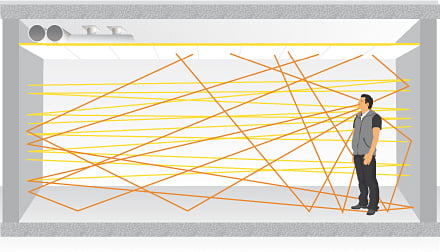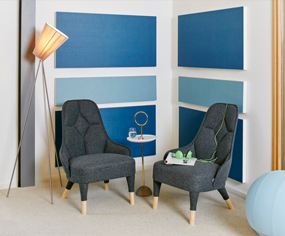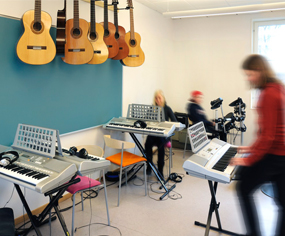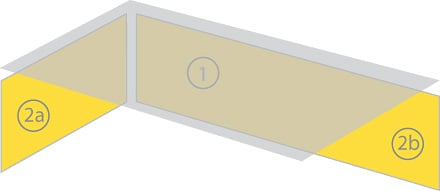Vertical acoustics

To be able to create an optimal sound environment, you'll need different kinds of sound absorbers. A sound-absorbing ceiling dramatically reduces the overall sound level and sound propagation in a room. But bare walls will still create echoes.
Vertical absorbers reduce these echoes and enhance speech clarity, so you can actually clearly hear what people are saying.
The amount of vertical absorption you'll need will depend on the activity taking place and the space itself:
In open-plan offices it’s important to stop speech and sound from spreading, and to minimize the disturbance of co-workers.
In schools students need a good learning environment to hear the teacher and each other, and to be able to think and reflect.
In healthcare premises, patients need peace to rest and recover,
and the staff must be able to communicate.
Learn more in our acoustic solutions section.
Acoustic parameters and how to apply them
rowspan="2" align="left" valign="top">
Reverberation time (RT) is by far the most frequently used parameter for calculations and measurements within room acoustics. The formulas used are normally the Sabine formula or some modified version of it. They are easy to use - you need the room volume and the amount of sound absorption, calculated with the absorption coefficient αp.
These formulas, however, are designed for ideal conditions with diffuse sound fields. In reality, the sound field is far from diffuse. It will probably consist of two main parts: one grazing and one non-grazing.

Grazing sound field
Non-grazing sound field

Grazing sound fields, which exist mainly in the mid and high frequencies, consist of sound energy developed in a plane parallel to a sound absorbing surface (normally the ceiling). The reverberation time in a room is mainly determined by the grazing sound fields. This means, in practice, that the reverberation time is considerably longer than the value calculated for diffuse sound fields.
The best way to control the sound energy in the grazing sound fields is to absorb it by using sound absorbers on walls. The sound energy can also be redirected towards the (sound-absorbing) ceiling by scattering or diffusion from furniture, interior fittings and surfaces.
Sound absorbers installed as small fields instead of large, unbroken areas will increase diffusion and further reduce reverberation time.
Added benefits with vertical absorbers
Many premises require really good room acoustics in order to reduce the noise level. The more sound absorption there is in a room, the lower the noise level will be. It has been shown that physical reduction of sound pressure levels (= less noise) in a room also results in additional sound reduction by psychological reaction: people talk more quietly.
With regard to environments requiring a high level of speech clarity, application of the C50 value might be a more appropriate parameter than reverberation time. Although STI is partly determined by the reverberation time, it is better correlated to the amount of sound absorption in the room. Adding sound absorption by placing absorbers on the walls will decrease the reverberation time, improve speech clarity intelligibility and also reduce the sound pressure level.
The amount of sound absorption can be used to calculate speech intelligibility and the reduction of the sound pressure level. It is not, however, safe nor reliable to calculate the reverberation time (RT) on the basis only of the amount of sound absorption.
Practical solutions with vertical acoustics
 There are a minimum of three things to take into consideration when treating a room acoustically:
There are a minimum of three things to take into consideration when treating a room acoustically:
-
the area available for sound treatment
-
the requirements for mechanical resistance
-
the aesthetics
The most common application is to partly cover a wall. From the acoustic point of view it is ideal to install wall panels on two adjacent walls in order to avoid flutter echo.
Another way of installing wall panels is to split them into smaller fields — or even use them singly, scattered over the wall. This can be done in regular or irregular patterns and provide an outlet for all sorts of creativity.
 A common way of arranging wall panels in, for example, classrooms or offices is to install a horizontal band of absorbers at a suitable height and use them as pin-boards. In this case too it is preferable to use more than one wall and to combine with a sound-absorbing ceiling.
A common way of arranging wall panels in, for example, classrooms or offices is to install a horizontal band of absorbers at a suitable height and use them as pin-boards. In this case too it is preferable to use more than one wall and to combine with a sound-absorbing ceiling.
The wall absorbers should be placed at the height of people’s ears in both the sitting and standing positions.
Corners are especially important for the acoustics - corners between walls and corners between the ceiling and the walls - sound absorbers perform optimally there.
In most cases it is an advantage to combine the wall absorbers with a suspended ceiling:

1) ceiling
2a) short wall
2b) long wall

